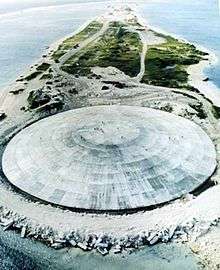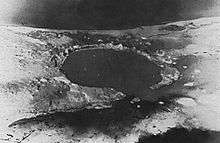Runit Island
Runit Island is one of 40 islands of the Enewetak Atoll of the Marshall Islands in the Pacific Ocean.
Runit Dome

On the shore of Runit Island, at sea level, is the Runit Dome. It contains 111,000 cubic yards of radioactive debris, a remnant from unsuccessful nuclear tests conducted by the United States between 1946 and 1958 where material that is radioactive for thousands of years spread. It was cleaned up and stored in the cement dome. A report by the US Department of Energy noted that soil around the dome is already more contaminated than its contents.[1]
An assessment of the Runit or "Cactus Dome", as it is also known, was released in 2013,[2] detailing the weathering and minor cracking of the structure. Lagoon water surrounding the structure contains a higher inventory of radionuclides and in the event of total collapse, the lagoon would not appreciably increase in danger. Concern primarily lays in the rapid tidal response to the height of the water beneath the debris pile, with the potential for contamination of the ground-water supply.
Gallery
-

Runit Island is part of the Enewetak Atoll
-

In 1952, the United States dropped the nuclear bomb Ivy King 610 m (2,000 feet) north of Runit Island.
-

Crater created by detonation on 5 May 1958 (Operation Hardtack I, Cactus test)
References
- ↑ Jan Hendrik Hinzel, Coleen Jose and Kim Wall. "Climate change threatens radioactive storage dome in south Pacific – video", The Guardian, 3 July 2015. Retrieved 27 July 2016.
- ↑ [https://marshallislands.llnl.gov/ccc/Hamilton_LLNL-TR-648143_final.pdf Visual Description of the Concrete Exterior of the Cactus Crater Containment Structure LLNL-TR-648143]
Coordinates: 11°32′42″N 162°21′11″E / 11.5450°N 162.3530°E